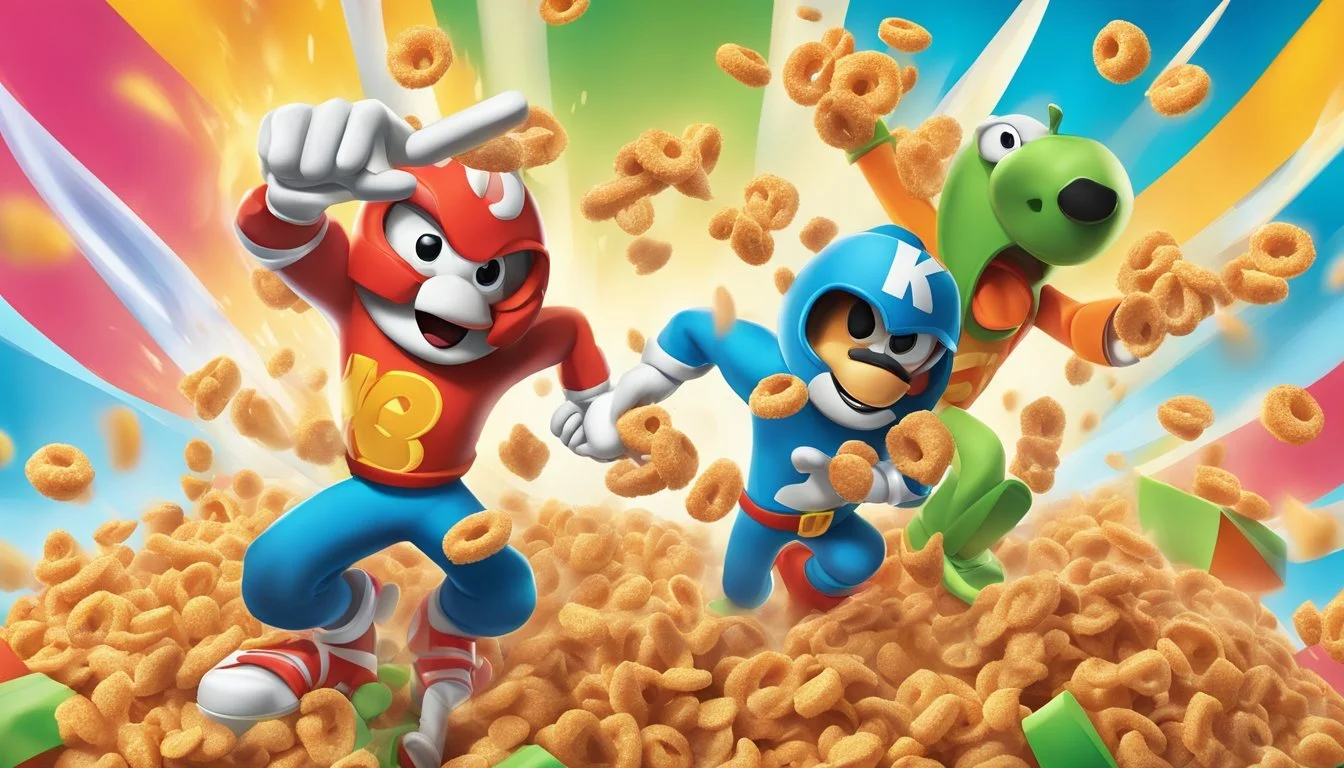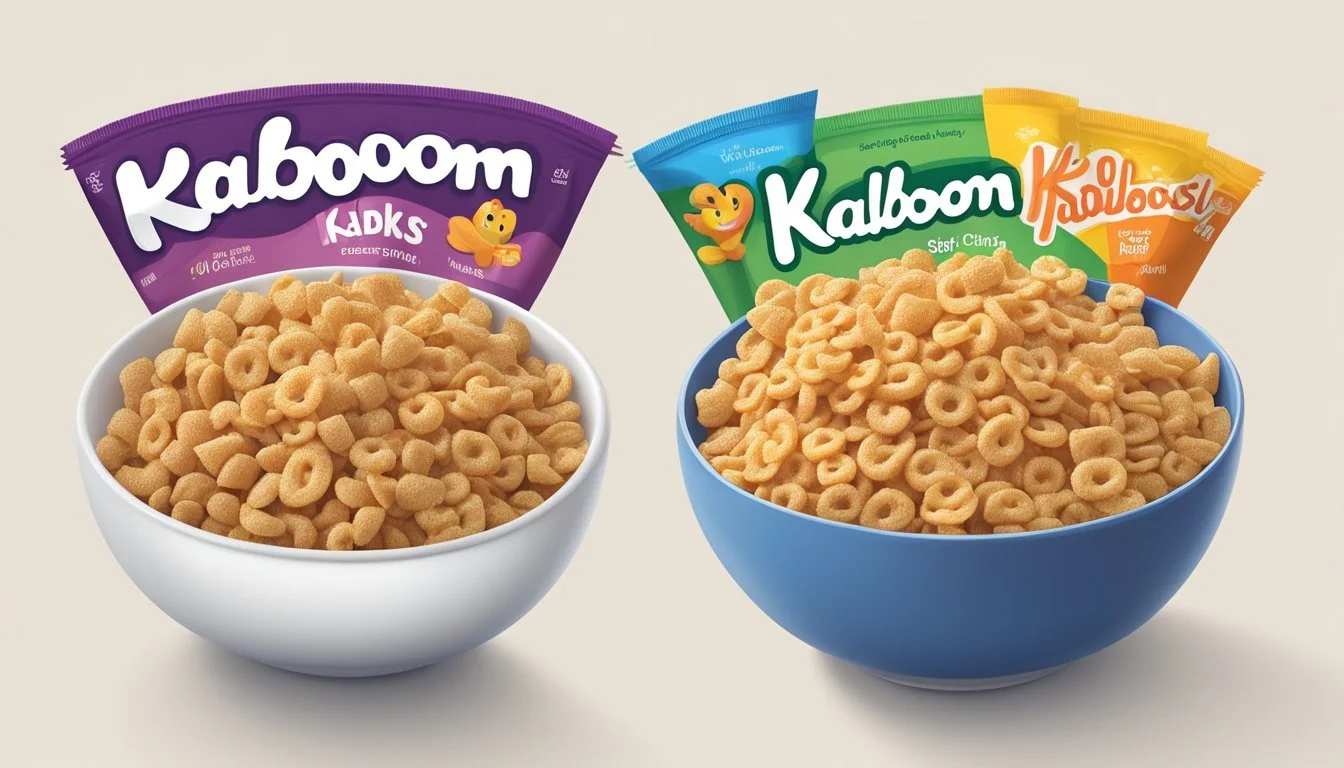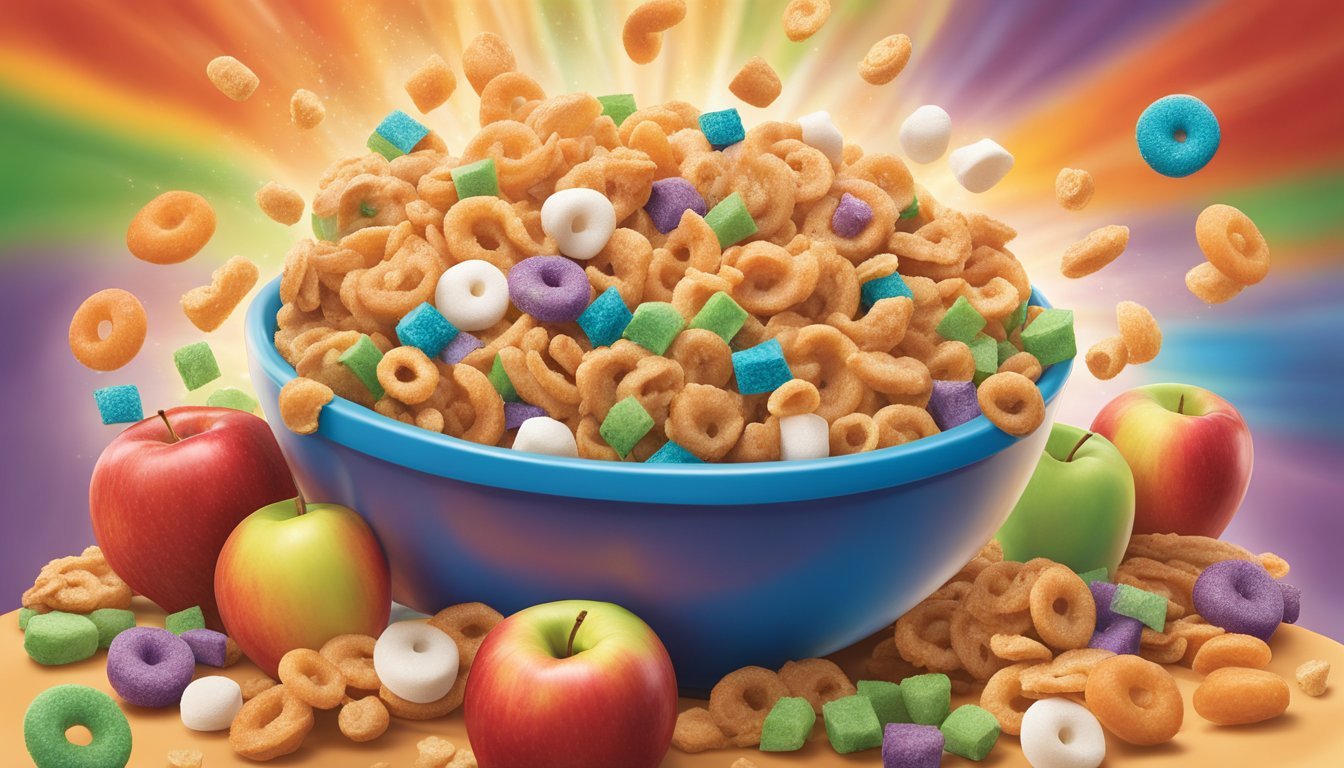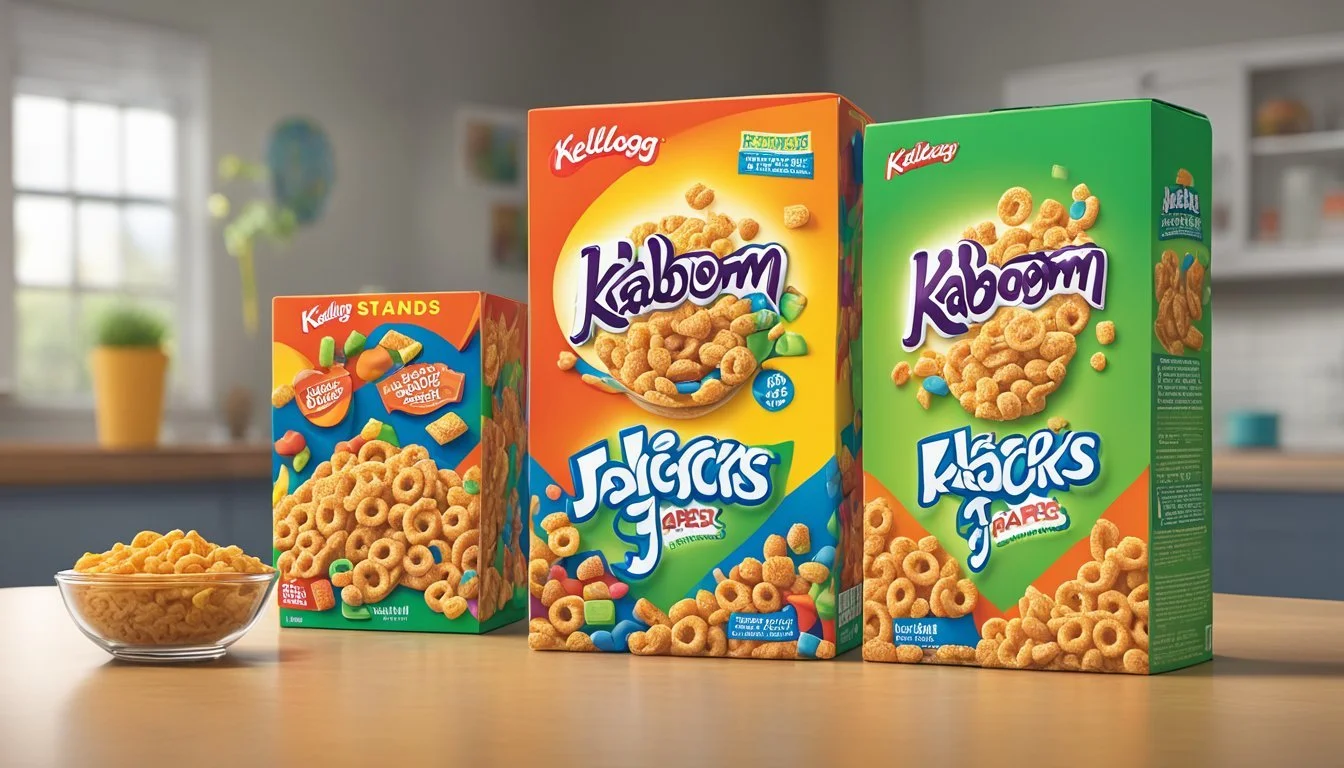Kaboom vs Kellogg's Apple Jacks
Comparing Two Popular Cereals
This Article is Part of Our Breakfast Cereal Guide with Details on Kaboom Nutrition and Kellogg's Apple Jacks Nutrition
Comparing Kaboom and Kellogg's Apple Jacks offers a fascinating look at two beloved breakfast cereals that have delighted children and adults alike for decades. Kaboom, known for its colorful, fun shapes, provides a sweet and crunchy experience that many remember fondly from their childhood. Kellogg's Apple Jacks, introduced in 1965, combines the distinct flavors of apple and cinnamon in a way that has made it a staple on breakfast tables worldwide.
Despite their differences, both cereals share a common goal: providing a tasty start to the day. Kaboom features a vibrant assortment of star-shaped pieces that appeal to the eye and the palate, while Apple Jacks offers a more subtle but equally enjoyable flavor profile. Nutritionally, both cereals are marketed towards children and contain relatively high sugar content, making them a topic of interest for parents concerned about healthy eating.
Exploring the ingredients, history, and cultural impact of Kaboom and Apple Jacks reveals unique stories behind their lasting popularity. Engaging with these details can help readers make informed choices about which of these nostalgic cereals best suits their breakfast needs.
Overview of Kaboom and Kellogg's Apple Jacks
Kaboom and Kellogg's Apple Jacks are two popular breakfast cereals that cater primarily to children.
Kaboom stands out with its bright, colorful shapes and a strong emphasis on providing essential nutrients. It is fortified with a wide range of vitamins and minerals, making it a nutritious choice for kids.
Kellogg's Apple Jacks offers a distinct apple and cinnamon flavor. First introduced in 1965, this cereal has maintained popularity over the years due to its unique taste profile.
Both cereals are part of a balanced breakfast, each offering unique nutritional benefits.
Cereal Key Ingredients Flavor Vitamins & Minerals Kaboom Corn flour, sugar Sweet, fruity Fortified with multiple vitamins and minerals Kellogg's Apple Jacks Corn flour blend, apples, cinnamon Apple and cinnamon Contains Vitamin B6, Iron, B12, and others
Kaboom provides a colorful and playful eating experience. It often attracts children with its vibrant appearance and fun shapes. The cereal is also known for its extensive vitamin and mineral content.
Kellogg's Apple Jacks delivers a sweet and slightly tangy taste that pairs well with milk.
It’s also a kid-friendly choice, owing to its playful name and appealing taste. This cereal is enriched with 15 grams of whole grains per serving and is an excellent source of seven vitamins and minerals.
History and Development
Kaboom and Kellogg's Apple Jacks have distinct origins and development paths, with each playing a unique role in the cereal market.
Origin of Kaboom
Kaboom was a breakfast cereal introduced by General Mills. Debuting in the 1960s, it featured a colorful array of clown-shaped pieces. This cereal aimed to attract children with its vibrant looks and sugary taste.
It was fortified with vitamins and minerals, touted as a nutritious option for kids. Over time, Kaboom became less prominent, and eventually, General Mills discontinued it. Despite its disappearance, Kaboom remains a nostalgic favorite for many.
Evolution of Kellogg's Apple Jacks
Kellogg's Apple Jacks was introduced in 1965. Invented by William Thilly, an intern at Kellogg's, the cereal combined apple and cinnamon flavors. Despite its name, it was designed to taste more like cinnamon than apples.
Originally round, Apple Jacks has seen various shapes like carrots and ghouls. Mascots like "Apple" and "CinnaMon" were introduced to engage young consumers and keep the brand relevant. Today, Apple Jacks is marketed in different regions by WK Kellogg Co and Kellanova, maintaining a significant presence globally.
Nutritional Comparison
Kaboom and Kellogg's Apple Jacks offer distinct nutritional profiles, making each cereal unique in its dietary contributions. Key areas of comparison include vitamin content, mineral content, and macronutrient profiles.
Vitamin Content
Kaboom tends to be fortified with a broader range of vitamins, focusing on covering daily nutritional needs. It's rich in Vitamin A, Vitamin D, and Vitamin C, catering well to children's nutritional requirements.
In contrast, Kellogg's Apple Jacks excels particularly in the B-vitamin category. It provides higher amounts of Vitamin B6, Vitamin B12, Vitamin B1, and Vitamin B2. Notably, this cereal exceeds the daily need for Vitamin B12 by a significant margin, offering around 225% of the recommended daily intake.
Mineral Content
Mineral content varies between these cereals. Kaboom offers a substantial quantity of Iron and Calcium, supporting bone health and oxygen transportation in the body.
Kellogg's Apple Jacks also provide a robust mineral profile. This cereal is particularly strong in Zinc, Iron, and Phosphorus. Zinc aids in immune function, while Phosphorus is essential for energy production. Both cereals offer Iron, but Apple Jacks provides it in a higher concentration.
Macronutrient Profile
Kaboom is higher in fiber and generally offers more protein, supporting satiety and muscle maintenance. This cereal is also designed to have a balanced amount of fat, carbohydrates, and calories, suitable for a breakfast option.
Kellogg's Apple Jacks, on the other hand, are relatively lower in fiber but higher in carbohydrates, delivering a quick energy boost. It maintains a moderate level of protein and has a lower fat content, particularly low in saturated fat.
Both cereals cater to different nutritional needs and preferences, making each a viable option depending on dietary requirements.
Health and Diet Considerations
When comparing Kaboom and Kellogg's Apple Jacks, it's important to evaluate their compatibility with various dietary needs as well as how serving size affects consumption and nutritional intake.
Diet Compatibility
Kaboom and Apple Jacks offer varying levels of essential nutrients. Kaboom is reputed for higher vitamins and minerals daily need coverage scores, making it a better choice for those seeking an enriched vitamin profile.
Apple Jacks, known for their higher sugar content, may not be suitable for low-glycemic index or low-sugar diets.
On the other hand, Kaboom generally contains less sugar, which can be a benefit for those managing blood sugar levels. Both cereals are relatively low in fats and calories, appealing to low-calorie diets.
However, Apple Jacks contain more sodium, which could be a concern for those monitoring their sodium intake. Both options have minimal fiber, limiting benefits for digestive health.
Serving Size and Moderation
Portion control is critical with sugary cereals. Kaboom’s serving size is typically around 30g, while Apple Jacks' serving size reported as 18g might lead consumers to pour more, misleading them about their actual intake.
Here's a breakdown of nutrients per suggested serving:
Apple Jacks:
Calories: 70-150
Sugar: 13g
Fat: 0.5-1.5g
Sodium: 95-210mg
Carbohydrates: 16-34g
Kaboom:
Calories: 110-140
Sugar: 9-12g
Fat: 0.5-1g
Sodium: 85-140mg
Carbohydrates: 22-28g
Moderation is key to maintaining a balanced diet, especially given that cereals can be calorie-dense and high in sugar. Adjusting portion sizes to align with dietary needs can help mitigate adverse impacts. Pairing these cereals with elements like milk or fruit can also provide a more balanced meal.
Flavor Profile and Ingredients
Kaboom and Kellogg's Apple Jacks each offer distinct taste experiences and have unique ingredient profiles. This section explores the flavor elements and core ingredients that define these two cereals.
Taste Experience
Kaboom cereal provides a fruity and sweet taste, with each bite delivering a burst of fruit-flavored crunch. The artificial fruit flavors are complemented by a noticeable sugar coating, making Kaboom enjoyable for those who like their cereals on the sweeter side.
Apple Jacks, on the other hand, is known for its apple and cinnamon flavor combination. The orange and green O-shaped pieces offer a balanced sweetness, with the cinnamon providing a warm, mildly spicy undertone. The crisp texture enhances the overall eating experience, making it a favorite among those who appreciate a flavorful and crunchy breakfast cereal.
Ingredient Analysis
Kaboom's ingredient list features corn flour as its primary grain, alongside sugar and oat flour. The added sugars and artificial flavorings contribute to its fruity and vibrant taste. It also contains wheat flour and vitamins, including whole grain oat flour for added nutritional value.
Apple Jacks primarily uses corn flour and wheat flour as its main grains. It is sweetened with added sugar and enriched with cinnamon to achieve its signature taste. Nutritional additives like vitamins and minerals are included to enhance its value. The cereal's apple and cinnamon flavor comes from both natural and artificial sources, providing a recognizable taste that appeals to many breakfast enthusiasts.
Both cereals offer a significant amount of sugar per serving, contributing to their sweet flavor profiles. The selection of grains and added flavors in each product creates a unique breakfast option catering to different taste preferences.
Comparisons with Similar Products
Kaboom and Kellogg's Apple Jacks are longstanding favorites, but how do they stack up against other popular cereals like Froot Loops, Frosted Flakes, and Jumbo Snax? This section dives into these comparisons to highlight key differences and similarities.
Comparison with Froot Loops
When comparing Kaboom and Froot Loops, an immediate focus is on ingredients and nutritional facts. Both cereals are colorful, aiming to attract children. Ingredients such as corn flour, sugar, and oat flour are common in both.
Kaboom edges ahead in vitamin content. It often contains higher levels of essential vitamins like Vitamin A and B6. Froot Loops, on the other hand, tend to have higher sugar content, with 12-16g per serving compared to Kaboom.
Kaboom has a distinctive multi-grain composition, while Froot Loops primarily uses refined grains. This can make Kaboom slightly more favorable for those looking for a multigrain option.
Comparison with Frosted Flakes
Frosted Flakes, known for their sugary coating, differ significantly from Kaboom. Nutritional content is a major area of difference.
Kaboom offers a higher mineral comparison score due to its comprehensive fortification. It includes more iron and calcium compared to Frosted Flakes. Frosted Flakes, however, tend to be higher in Vitamin C, which Kaboom lacks.
In terms of texture and flavor, Frosted Flakes are crisply sweet, providing a noticeable crunch. Kaboom’s texture is often softer, attributed to its multigrain blend. Frosted Flakes are less likely to offer the same variety of grains found in Kaboom.
Comparison with Jumbo Snax
Jumbo Snax, a cereal snack variant, adds a unique twist to traditional cereals by focusing on portability and snacking convenience. Kaboom, as a traditional breakfast cereal, serves a different purpose.
Ingredient composition is another focal point. Jumbo Snax often mirrors popular Kellogg’s cereals like Apple Jacks in snack form. Kaboom differentiates with its robust nutrient profile, offering a better vitamin comparison score.
Caloric content is also different. Jumbo Snax, designed for snacking, may have smaller portion sizes with different calorie counts, while Kaboom maintains the classic breakfast cereal approach.
The serving context thus varies immensely between these products – snacking versus a complete meal.
Consumer Information
Comparing Kaboom and Kellogg's Apple Jacks provides valuable insights into their packaging and branding as well as their pricing and value for money.
Packaging and Branding
Kaboom and Kellogg's Apple Jacks present distinct visual identities. Kaboom cereal is known for its vibrant, cartoonish box design featuring colorful clowns and playful motifs, heavily appealing to children.
Kellogg's Apple Jacks, on the other hand, showcases depictions of apples and cinnamon sticks with an energetic, dynamic layout. The packaging highlights the presence of 7 vitamins and minerals, emphasizing nutritional benefits.
Apple Jacks' branding underscores the fun, "apple cinnalicious" flavors, reinforcing its appeal among kids and nostalgic adults. Both brands aim to attract children's attention but use different visual strategies to stand out in the market.
Pricing and Value for Money
Kaboom and Kellogg's Apple Jacks cater to budget-conscious consumers but occupy different price points. Kaboom is typically more affordable, often positioned as a cost-effective alternative without sacrificing the fun factor for children.
Kellogg's Apple Jacks, priced slightly higher, justifies its cost with its promise of 7 vitamins and minerals and a well-established brand reputation. The price of Apple Jacks generally ranges around $3-$4 for a standard box, reflecting its premium positioning.
Consumers willing to pay a bit more for the added nutritional content and established quality might favor Apple Jacks. Alternatively, Kaboom offers value for those looking for an economical yet enjoyable cereal option.
Manufacturing and Safety
Kellogg's Apple Jacks and Kaboom cereals both prioritize quality and safety in their manufacturing processes, ensuring that their products meet high standards for consumer health and satisfaction. This section will explore the rigorous protocols they employ.
Quality Control
Both Kellogg's and the producers of Kaboom implement stringent quality control measures. The manufacturing process includes multiple stages of testing for ingredients such as vegetable oil, salt, and oat fiber. Each batch undergoes evaluation to ensure that only the highest quality components are used.
Apple Jacks includes ingredients like hydrogenated coconut, soybean, and cottonseed oils, which are tested for purity and consistency.
Kaboom, known for its multicolored appearance, employs color-testing to maintain the right balance of Yellow 6, Red 40, and Blue 1.
Inspections are performed at various stages:
Inspection of Raw Materials: Ensuring raw materials meet quality criteria before production.
In-Process Inspections: Monitoring during production to catch and address quality issues immediately.
Final Product Testing: Ensuring the finished product meets all specifications before packaging.
The emphasis on quality control minimizes the chances of contaminants and ensures the cereals meet consumer expectations.
Food Safety Standards
Food safety is paramount in the production of both Apple Jacks and Kaboom. Compliance with stringent food safety standards is a core aspect. This includes adhering to guidelines set by regulatory bodies such as the FDA and USDA.
Ingredients such as modified food starch, reduced iron, niacinamide, and folic acid must meet specified safety criteria. The use of pesticide-free grains and non-GMO ingredients is also prioritized.
Safety measures include:
HACCP Implementation: Identifying and controlling potential hazards in the production process.
Sanitation Protocols: Regular cleaning and sanitization of equipment to prevent contamination.
Allergen Control: Managing ingredients like milk and soybean to prevent cross-contamination.
Frequent audits and compliance checks ensure that the cereals not only taste good but are also safe for consumption.
More on Kaboom
More on Kellogg's Apple Jacks
Cinnamon Toast Crunch vs Kellogg's Apple Jacks: Which is better?
French Toast Crunch vs Kellogg's Apple Jacks: Which is better?
Honey Nut Cheerios vs Kellogg's Apple Jacks: Which is better?
Kellogg's Apple Jacks vs Kellogg's Froot Loops: Which is better?
Kellogg's Apple Jacks vs Post GrapevsNut Flakes: Which is better?
Kellogg's Apple Jacks vs Post Raisin Bran Cereal: Which is better?








